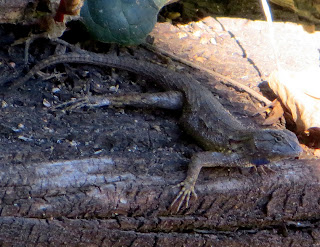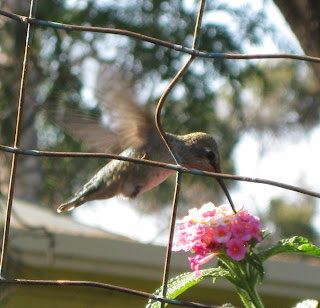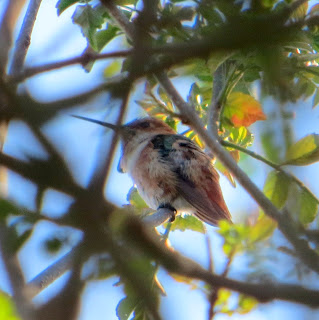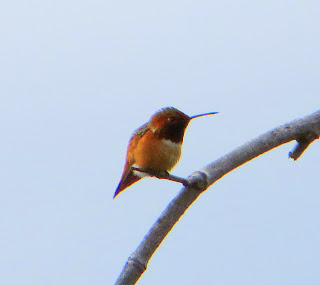Today I didn't see anything special. There were no thrushes or chickadees, or at least I didn't see them. The persimmons are all gone, so there are no more birds in that tree.
I saw my first two lizards of the year. It was quite a bit warmer today than it has been, so the little reptiles were out sunbathing. Here's one of the lizards. I only noticed it because it was next to a yellow-rumped warbler (which didn't stay still for a photo). The lizard is a western fence lizard.
 |
| Western Fence Lizard |
Advice
When putting out hummingbird feeders, put them in the shade. If they are in direct sunlight, the water will evaporate faster, and it can leave a sticky mess inside. Also, make sure to put something to keep the ants and other insects out. Many stores sell such things, like cups of water that hang above the feeder on the same string.
Hummingbirds are not the only birds attracted to sugar water. Often, large, colorful orioles will come to hummingbird feeders. If you are worried that the orioles will scare away the hummingbirds or drink up all the sugar water, there are special feeders available just for orioles, or try putting out jam or oranges cut in half.
Sometimes there are problems with feeders, such as bugs that have found a way to get around the water cup, or the feeder is just too messy. If that is the case, try planting flowers. Hummingbirds seem to particularly like tube-shaped flowers. If you plant flowers, native flowers are always best. If you plant a non-native flower, try not to plant something that is likely to spread.
The hummingbird advice is because I saw both Anna's and Allen's hummingbirds today. That isn't unusual, but today I got photos of both of them.
Anna's hummingbirds are the most common hummingbirds in my area. They are found all year round in the far western part of the United States. The females are grayish-green overall and paler underneath. The males are brighter green with bright red iridescent heads. They, like most other hummingbirds, make very high pitched whistling and buzzing noises, and are very fearless. I've even seen them chasing hawks. Below are three photos of female Anna's hummingbirds. I haven't been able to take a photo of a male yet.
 |
| Anna's Hummingbird |
 |
| Anna's Hummingbird |
 |
| Anna's Hummingbird |
Allen's hummingbirds are found in the summer in southwestern Oregon, California, and Arizona. They are also found in Mexico, and rarely in the southeastern United States. In a very small part of coastal southern California, including where I live, they are around all year. Allen's hummingbirds, unlike Anna's, have reddish patches on their faces, tails, and bellies. They are very similar to rufous hummingbirds. The male Allen's, unlike the rufous, has a green cap and back. The females, however, are almost impossible to distinguish from each other. I only know the female hummingbirds I'm seeing are Allen's because the rufous is only here in the summer and isn't as common. Below are two photos, the first of a female Allen's, the second of a male.
 |
| Allen's Hummingbird |
 |
| Allen's Hummingbird |